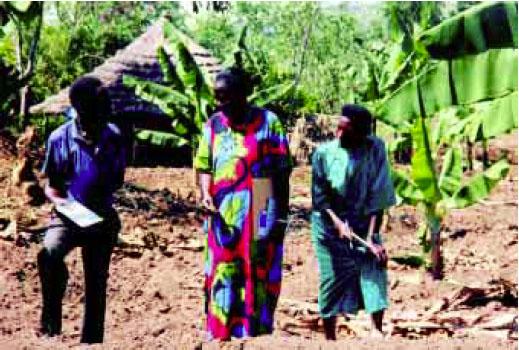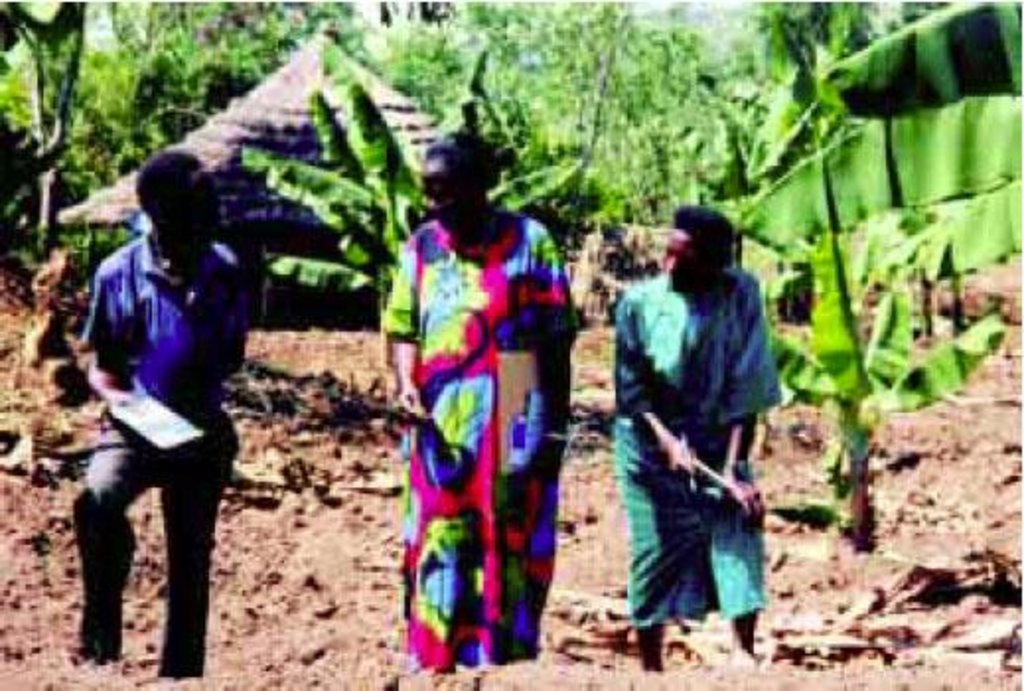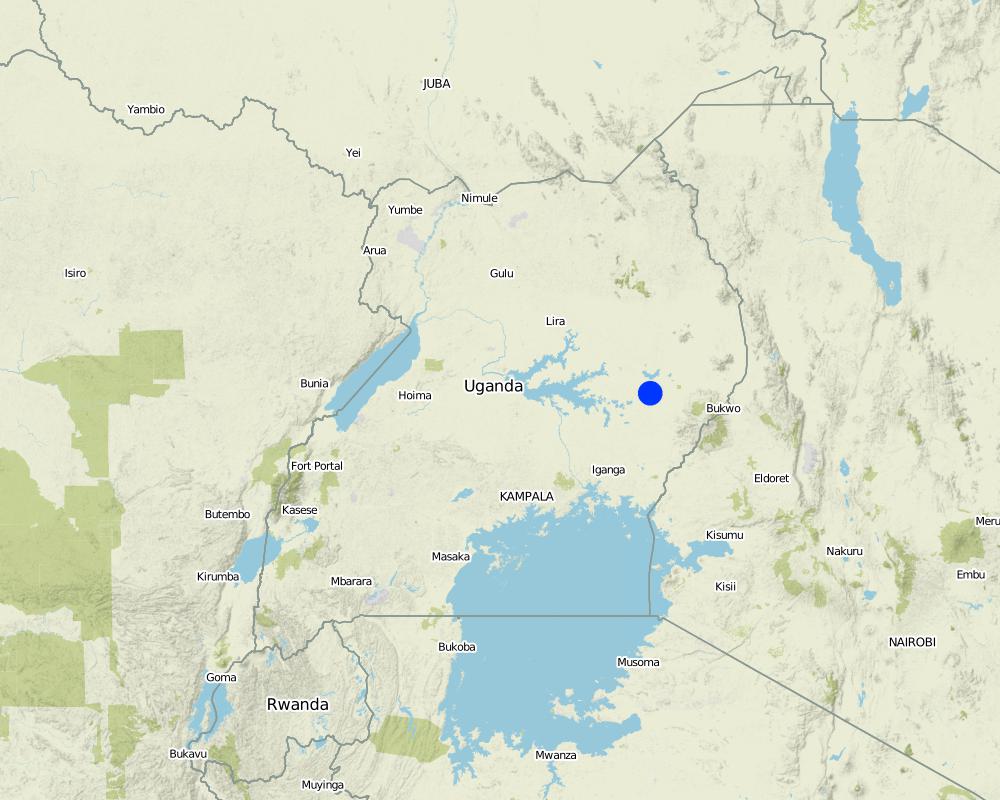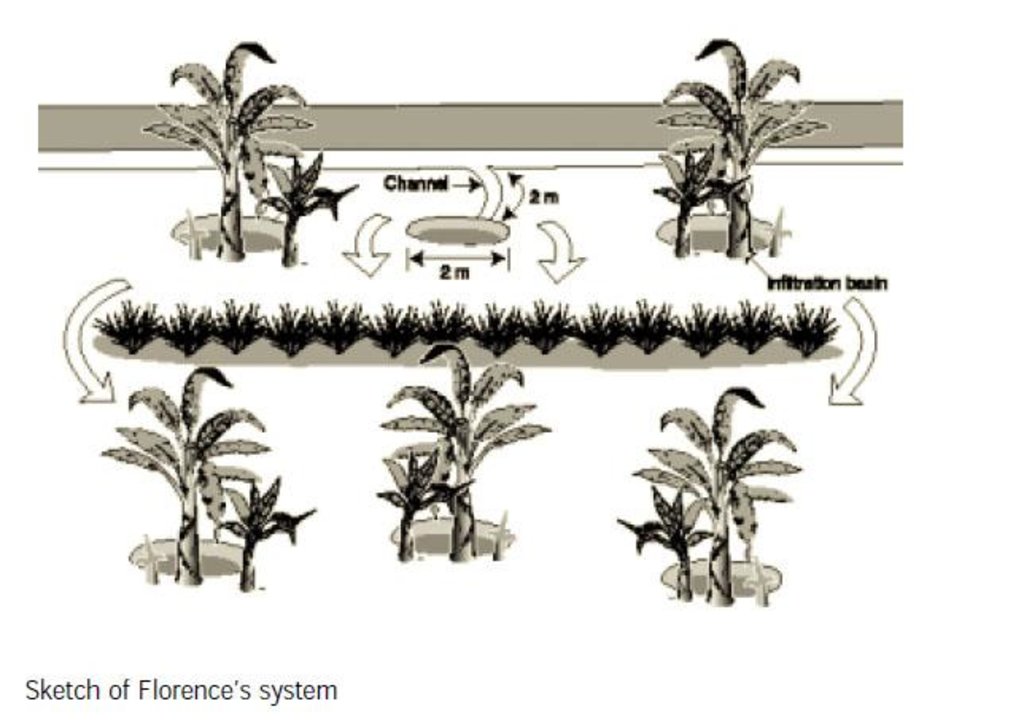Runoff water harvesting for bananas [Uganda]
- Creation:
- Update:
- Compiler: Alex Lwakuba
- Editor: –
- Reviewers: Fabian Ottiger, Alexandra Gavilano
technologies_1390 - Uganda
View sections
Expand all Collapse all1. General information
1.2 Contact details of resource persons and institutions involved in the assessment and documentation of the Technology
SLM specialist:
Imoko-otim Charles, P.
MMAIF, DEPT of Agriculture
Uganda
Name of the institution(s) which facilitated the documentation/ evaluation of the Technology (if relevant)
Ministry of Agriculture, Animal Industry, and Fisheries of Uganda (MAAIF) - Uganda1.3 Conditions regarding the use of data documented through WOCAT
The compiler and key resource person(s) accept the conditions regarding the use of data documented through WOCAT:
Yes
2. Description of the SLM Technology
2.1 Short description of the Technology
Definition of the Technology:
Run off water from a hill is harnessed and concentrated in a banana plantation using diversion and retention ditches respectively.
2.2 Detailed description of the Technology
Description:
Runoff water is diverted from the road running by the farm, using diversion ditches, 0.3 m deep and 0.3 m wide. Water is led first into semi-circular infiltration ditches that are 0.3 m deep, and 2 m in diameter. From these ditches, water flows through the banana plantation and is held by infiltration basins around which are groups of banana stools. Setaria grass is planted to stabilize the edges of the basins and is also used to stabilize a bund which runs through the plantation. Mulching is practised throughout the plantation,
primarily to reduce the loss of valuable moisture.
Purpose of the Technology: The technology is used to control soil erosion by runnig water from the hill top and also to harvest water and retain soil moisture for the banana palms which need adequate soil moisture for proper production. Dry vegetation and stover are used as mulch to reinforce moisture conservation.
Establishment / maintenance activities and inputs: The ditches are maintained by removing silt regularly. The grass is cut to avoid over growing.
Natural / human environment: The technology is applied on perennial crop land located in a semi arid area. The soil is predominantly sandy loam and shallow. Florence is a farmer and a married housewife. She is 40 years old and has a family of 12 to support
despite the fact the family is poorer than average. They own less than one hectare of land, but borrow an extra area to cultivate. Her main technical initiative is water harvesting, together with soil fertility improvement, in a matooke (cooking banana) plantation. She started in 1990. She practices harvesting of water from the road into her plantation, and has a system of trenches through which water circulates and is then held by basins around which are banana stools. She also mulches and plants grass barriers within
the plantation. There is some doubt whether the water harvesting can really be claimed as her own innovation, as there are variations of this practice in several nearby farms. Nevertheless her holistic management system is probably unique to the area.
2.3 Photos of the Technology
2.5 Country/ region/ locations where the Technology has been applied and which are covered by this assessment
Country:
Uganda
Region/ State/ Province:
Kumi
Further specification of location:
Kumi
Specify the spread of the Technology:
- evenly spread over an area
If precise area is not known, indicate approximate area covered:
- 1-10 km2
Comments:
Total area covered by the SLM Technology is 10 km2.
Map
×2.6 Date of implementation
If precise year is not known, indicate approximate date:
- more than 50 years ago (traditional)
2.7 Introduction of the Technology
Specify how the Technology was introduced:
- as part of a traditional system (> 50 years)
Comments (type of project, etc.):
it is a farmer own intiative
3. Classification of the SLM Technology
3.1 Main purpose(s) of the Technology
- improve production
- reduce, prevent, restore land degradation
- create beneficial economic impact
3.2 Current land use type(s) where the Technology is applied

Cropland
- Annual cropping
- Perennial (non-woody) cropping
- Setaria grass
Perennial (non-woody) cropping - Specify crops:
- banana/plantain/abaca
Number of growing seasons per year:
- 2
Specify:
Longest growing period in days: 90Longest growing period from month to month: Mar - JunSecond longest growing period in days: 90Second longest growing period from month to month: Sep - Nov
Comments:
Major land use problems (compiler’s opinion): adequate soil moisture, soil erosion by wind and running water, and declining soil fertility
Major land use problems (land users’ perception): unreliable rainfall, soil erosion, pest and diseases and inadequate capital
3.4 Water supply
Water supply for the land on which the Technology is applied:
- mixed rainfed-irrigated
Comments:
water harvesting
irrigation management (incl. water supply, drainage)
water diversion and drainage
3.5 SLM group to which the Technology belongs
- water harvesting
- irrigation management (incl. water supply, drainage)
- water diversion and drainage
3.6 SLM measures comprising the Technology
3.7 Main types of land degradation addressed by the Technology

soil erosion by water
- Wt: loss of topsoil/ surface erosion

water degradation
- Ha: aridification
Comments:
Main type of degradation addressed: Wt: loss of topsoil / surface erosion, Ha: aridification
3.8 Prevention, reduction, or restoration of land degradation
Specify the goal of the Technology with regard to land degradation:
- prevent land degradation
4. Technical specifications, implementation activities, inputs, and costs
4.1 Technical drawing of the Technology
Technical specifications (related to technical drawing):
Water harvesting for banana cultivation
Location: Kumi. Uganda
Technical knowledge required for field staff / advisors: low
Main technical functions: control of dispersed runoff: retain / trap, improvement of soil structure, water harvesting
Vegetative measure: on top of earth workd
Vegetative material: G : grass
Vegetative measure: Vegetative material: G : grass
Vegetative measure: Vegetative material: G : grass
Vegetative measure: Vegetative material: G : grass
Trees/ shrubs species: mango
Perennial crops species: bananas
Grass species: setaria
Retention/infiltration ditch/pit, sediment/sand trap
Vertical interval between structures (m): R
Spacing between structures (m): R
Depth of ditches/pits/dams (m): 0.3
Width of ditches/pits/dams (m): 1.5
Length of ditches/pits/dams (m): R
Structural measure: diversion ditch/cut-off drain
Vertical interval between structures (m): r
Spacing between structures (m): r
Depth of ditches/pits/dams (m): 0.3
Width of ditches/pits/dams (m): 0.3
Length of ditches/pits/dams (m): R
Height of bunds/banks/others (m): 0.3
Width of bunds/banks/others (m): 0.3
Length of bunds/banks/others (m): R
4.3 Establishment activities
| Activity | Timing (season) | |
|---|---|---|
| 1. | formation of bunds | dry season |
| 2. | planting grass | beginning of rains |
| 3. | digging ditches, making bunds | dry season |
| 4. | planting grass | beginning of rains |
| 5. | mulching | end of rain |
4.4 Costs and inputs needed for establishment
| Specify input | Unit | Quantity | Costs per Unit | Total costs per input | % of costs borne by land users | |
|---|---|---|---|---|---|---|
| Labour | Labour | ha | 1.0 | 120.0 | 120.0 | 100.0 |
| Equipment | Tools | ha | 1.0 | 50.0 | 50.0 | 100.0 |
| Plant material | Seedlings | ha | 1.0 | 200.0 | 200.0 | 100.0 |
| Total costs for establishment of the Technology | 370.0 | |||||
| Total costs for establishment of the Technology in USD | 370.0 | |||||
Comments:
Duration of establishment phase: 12 month(s)
4.5 Maintenance/ recurrent activities
| Activity | Timing/ frequency | |
|---|---|---|
| 1. | cuttin back | /each cropping season |
| 2. | mulching banana | /twice a season |
| 3. | desilting | rainy/each cropping season |
| 4. | cutting back the grass | when overgrown/each cropping season |
| 5. | mulching | each cropping season |
4.6 Costs and inputs needed for maintenance/ recurrent activities (per year)
| Specify input | Unit | Quantity | Costs per Unit | Total costs per input | % of costs borne by land users | |
|---|---|---|---|---|---|---|
| Labour | Labour | ha | 1.0 | 1440.0 | 1440.0 | 100.0 |
| Equipment | Tools | ha | 1.0 | 50.0 | 50.0 | 100.0 |
| Total costs for maintenance of the Technology | 1490.0 | |||||
| Total costs for maintenance of the Technology in USD | 1490.0 | |||||
Comments:
labour, length of structure
4.7 Most important factors affecting the costs
Describe the most determinate factors affecting the costs:
labour, soil depth, tools
5. Natural and human environment
5.1 Climate
Annual rainfall
- < 250 mm
- 251-500 mm
- 501-750 mm
- 751-1,000 mm
- 1,001-1,500 mm
- 1,501-2,000 mm
- 2,001-3,000 mm
- 3,001-4,000 mm
- > 4,000 mm
Agro-climatic zone
- semi-arid
5.2 Topography
Slopes on average:
- flat (0-2%)
- gentle (3-5%)
- moderate (6-10%)
- rolling (11-15%)
- hilly (16-30%)
- steep (31-60%)
- very steep (>60%)
Landforms:
- plateau/plains
- ridges
- mountain slopes
- hill slopes
- footslopes
- valley floors
Altitudinal zone:
- 0-100 m a.s.l.
- 101-500 m a.s.l.
- 501-1,000 m a.s.l.
- 1,001-1,500 m a.s.l.
- 1,501-2,000 m a.s.l.
- 2,001-2,500 m a.s.l.
- 2,501-3,000 m a.s.l.
- 3,001-4,000 m a.s.l.
- > 4,000 m a.s.l.
5.3 Soils
Soil depth on average:
- very shallow (0-20 cm)
- shallow (21-50 cm)
- moderately deep (51-80 cm)
- deep (81-120 cm)
- very deep (> 120 cm)
Topsoil organic matter:
- medium (1-3%)
If available, attach full soil description or specify the available information, e.g. soil type, soil PH/ acidity, Cation Exchange Capacity, nitrogen, salinity etc.
Soil fertility: Medium
Soil drainage/infiltration: Good
Soil water storage capacity: Low
5.6 Characteristics of land users applying the Technology
Market orientation of production system:
- subsistence (self-supply)
- mixed (subsistence/ commercial)
Off-farm income:
- less than 10% of all income
Relative level of wealth:
- rich
Level of mechanization:
- manual work
Indicate other relevant characteristics of the land users:
Population density: 10-50 persons/km2
Annual population growth: > 4%
10% of the land users are rich and own 20% of the land.
25% of the land users are average wealthy and own 30% of the land.
60% of the land users are poor and own 50% of the land.
5% of the land users are poor.
Off-farm income specification: most of the income is derived from the farm, however some members are employed outside.
Level of mechanization: Manual work (only family labour)
Market orientation: Mixed and subsistence (bananas produced for home consumption and surplus for sell)
5.7 Average area of land used by land users applying the Technology
- < 0.5 ha
- 0.5-1 ha
- 1-2 ha
- 2-5 ha
- 5-15 ha
- 15-50 ha
- 50-100 ha
- 100-500 ha
- 500-1,000 ha
- 1,000-10,000 ha
- > 10,000 ha
5.8 Land ownership, land use rights, and water use rights
Land ownership:
- individual, not titled
- customary
Land use rights:
- individual
6. Impacts and concluding statements
6.1 On-site impacts the Technology has shown
Socio-economic impacts
Production
crop production
Income and costs
farm income
Comments/ specify:
From sales of bananas
workload
Other socio-economic impacts
Intercropping
Socio-cultural impacts
community institutions
Comments/ specify:
Through farm visits and trainings
national institutions
SLM/ land degradation knowledge
Ecological impacts
Water cycle/ runoff
excess water drainage
Soil
soil moisture
soil cover
soil loss
nutrient cycling/ recharge
Other ecological impacts
Exposure
Comments/ specify:
To other skills
6.2 Off-site impacts the Technology has shown
downstream flooding
Comments/ specify:
Grass strips and retention ditches
downstream siltation
6.4 Cost-benefit analysis
How do the benefits compare with the establishment costs (from land users’ perspective)?
Short-term returns:
slightly positive
Long-term returns:
positive
How do the benefits compare with the maintenance/ recurrent costs (from land users' perspective)?
Short-term returns:
slightly positive
Long-term returns:
positive
6.5 Adoption of the Technology
If available, quantify (no. of households and/ or area covered):
50% of area covered
Comments:
60% of land user families have adopted the Technology without any external material support
100 land user families have adopted the Technology without any external material support
Comments on spontaneous adoption: estimates
There is a moderate trend towards spontaneous adoption of the Technology
Comments on adoption trend: Water harvesting in bananas is becoming an increasingly common practice in Kumi District. It is not possible to say currently how many families have taken up this technology – or indeed how many of these can be directly attributed to Florence’s example.
6.7 Strengths/ advantages/ opportunities of the Technology
| Strengths/ advantages/ opportunities in the land user’s view |
|---|
|
big bunch of banana How can they be sustained / enhanced? maintain ditches |
| healthy banana plantation |
| increased food production |
| reduced weeding |
| increased income |
| Strengths/ advantages/ opportunities in the compiler’s or other key resource person’s view |
|---|
|
soil erosion control How can they be sustained / enhanced? continue desilting |
| harvesting of runoff |
|
improved soil conditions How can they be sustained / enhanced? continue mulching |
| improved yields and size of the bunches |
| increased income |
6.8 Weaknesses/ disadvantages/ risks of the Technology and ways of overcoming them
| Weaknesses/ disadvantages/ risks in the land user’s view | How can they be overcome? |
|---|---|
| labour is very expensive | need labour and money |
| time consuming |
| Weaknesses/ disadvantages/ risks in the compiler’s or other key resource person’s view | How can they be overcome? |
|---|---|
| labour intensive | need of tools and money to pay the casuals |
7. References and links
7.1 Methods/ sources of information
7.2 References to available publications
Title, author, year, ISBN:
Kithinji M., Critchley W. 2001. Farmers' initiatives in land husbandry: Promising technologies for the drier areas of East Africa. RELMA Technical Report series no. 27
Title, author, year, ISBN:
Atlas of Uganda (1967) Dept of land and survey
Title, author, year, ISBN:
Entebbe Ministry of Agriculture, animal industry and fisheries, progress report on promoting farmers innovatio project (1997-2000) (Draft)
Title, author, year, ISBN:
Entebbe FAO - UNESCO (1990) Soil map of the world food and Agriculture org.
Title, author, year, ISBN:
ROMR The soil of Eastern Region of Uganda(1964) Dept of land and survey Entebbe
Links and modules
Expand all Collapse allLinks
No links
Modules
No modules





